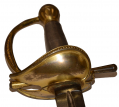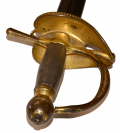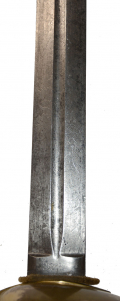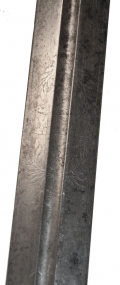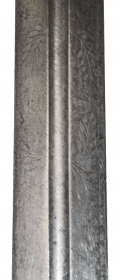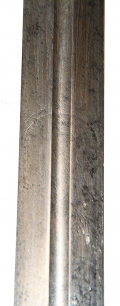site search
online catalog
US ORDNANCE INSPECTED MODEL 1832/34 OFFICER’S SWORD

$2,950.00
Quantity Available: 1
Item Code: 870-318
Shipping: Determined by Method & Location of buyer
To Order:
Call 717-334-0347,
Fax 717-334-5016, or E-mail
This is a very scarce US Model 1832/34 sword for officers of infantry, artillery and ordnance made by Ames on contract with the U.S. government for officers of the regular army and inspected by Major Henry Knox Craig, Chief Inspector of Contract Arms, based at Watertown Arsenal. The sword, formerly in the well-respected collection of Kevin Hoffman, shows a variation in placement of the inspection marks and the Ames address. The contract was for just 500 swords like this with gilt brass mounted leather scabbards and another 14 with metal scabbards for the general staff. The sword was specified in uniform regulations of 1832 and some blades were proofed in 1833, but inspection of completed swords only began in 1834, and the pattern was regulation only until the introduction of new patterns in 1840. Completion and inspection of the swords was done in batches over time at unclear intervals with changes in manufacture and inspectors providing a number of small variations for the collector and student. This one notably has the inspection and acceptance stamps visible on the ricasso of the blade rather than on the blade tang and concealed by the grip. Peterson omitted the sword from his “American Swords,” but it is covered by Dick Johnson’s article in Man at Arms and Thillmann’s “U.S. Army Swords.”
This sword is complete with its original scabbard, follows the standard pattern, and rates very good for condition. The hilt and scabbard mounts retain traces of the gilt finish, the hilt shows just a few minor dings to the sheet silver grip; the blade is full length with good edge and point, and light, but legible etching; the scabbard shows crazing to the finish, but good color and stitching to the seam.
The hilt is gilt brass with a globular pommel, two-piece, smooth on top and fluted on the bottom half, surmounted by a square nut secured the threaded blade tang, but rather tall in imitation of a capstan rivet and bearing a raised star design. The upper portion of the pommel shows some darker, patinaed brass from old handling, with the gilt stronger on the lower portion of the pommel and the rest of the hilt. The knucklebow is slit for a sword knot and beaded along the sides, with tall, cylindrical quillons that widen toward the tips extending above and below the sides of the hollow, “boat shaped” guard inspired by British patterns, and beaded along the obverse edge to match the knucklebow. The grip is made of sheet silver, impressed to simulate wire wrapping, and shows one shallow pressure dent, but no loss of detail on the false-wire impression. The leather pad is still in place on the blade shoulder on the underside of the guard, a feature specifically mentioned by Ames in correspondence.
The blade is straight, double-edged, with spearpoint tip and narrow central fuller. The edge and point are very good. The blade shows as a muted silver gray with scattered thin, darker gray age spots. The obverse ricasso bears the “ORD” acceptance stamp of the Ordnance Department and reverse bears the “H.K.C.” initials of Major Henry Knox Craig, applied with the same block “HKC” stamp he used inspecting Ames 1832 pattern short swords and Ames 1833 pattern dragoon sabers, all before his transfer to Allegheny Arsenal in September 1838. The markings are unusual on two counts: they appear on the ricasso, where they occasionally appear instead on the blade tang, concealed by the grip unless the sword is disassembled; and, they indicate inspection by Knox himself rather than subordinate James A. J. Bradford, who is known to have been sent by Craig to inspect the first 100-125 swords in May 1834. (Thillmann asserts all 1834 inspections of the pattern were done by Bradford, but this is unclear, or at least published testimony is lacking.)
The etching is light but legible. Thillmann notes the pattern can vary and was likely done by a sub-contractor called into the factory since blade etching would be something new to Ames. The etching incorporates the usual mix of floral, martial and patriotic motifs and both sides employ a panel at bottom with crossed cannon, above which a US flag, slightly furled, slants out to either side. This motif usually includes a Liberty Cap on tall pole at center, but this is indistinct. The top portion on each side uses a “theatre-box” panel, somewhat like tombstone shaped shako plate in some collectors’ view, with a dynamic American eagle with arrows and olive branch, flourishing a ribbon with the dry-point etched word “LIBERTY” and with stars overheard following the upper curve of the panel, which itself has the rays of a sunburst glory jutting up from the top edge.
Most unusual in the etching, however, is the positioning of the Ames address. The reverse shows a “U.S.” in block letters framed by a wreath at top and bottom. On the obverse of the blade the etcher has used the same two wreaths to frame “N.P. Ames / Cutler” on a ribbon near the middle of the etching, rather than in a scroll near the base of the blade. As noted above, Thillmann refers to variations in the blade etching, not suggesting it necessarily indicates different etchers, but likely results from the completion of the swords in batches over time. He suggests the appearance of crossed cannon in the etching may indicate the sword was intended for an officer in the artillery, but positioned with flags it may be a more generally applicable military/patriotic motif.
The scabbard is in very good condition with good color to the leather and cracking to the finish, but no large areas of flaking. The seam is good and the mounts shows the standard decoration of impressed sets of four lines each, encircling each mount. The mounts usually employ a single carrying ring and frog stud on the upper mount and a single ring on the middle. As Thillmann notes, however, the rings were weakly applied to the top edge of the mounts and were, in fact, superfluous since the sword was to be carried in a frog. We don’t see any trace of them here, but the frog stud is in place and shows wear.
The Model 1832/34 Officer’s Sword was first conceived of in 1831 in a move to adopt sword patterns for officers specific to a branch of service and more regulated than by mere specification of blade type and hilt color. Ames’s acceptance of the contract, however, nearly ruined the company. Craig had been instructed in May 1834 to inspect the Ames swords and to, “continue the inspection until the whole number has been completed,” so it looks like the company completed the contract, which also included some swords for officers in the dragoons, medical and pay departments. (Judging from orders to Dingee for the belts, the 500 swords with leather scabbards were divided into 14 for ordnance, 212 for artillery, and 273 for infantry officers.) The Secretary of War, however changed the standard payment terms, deeming it improper that the government buy the swords from Ames and then sell them at cost to officers, instead decreeing that the government would inspect the swords, but officers would order them from Ames and pay for them privately. It might have been expected that rival makers would compete on the commercial market for sales to militia officers, but Ames then had to compete not only with domestic manufacturers but even with British counterfeits bearing his own name for sales to regular army officers.
This is a very scarce example of a U.S. regulation sword for an officer in the regular army and a pattern with an interesting production history and use during the early expansion of the country. [sr][ph:L]
~~~~~~~~~~~~~~~~~~~~~~~~~~~~~~~~~~~
THIS ITEM, AS WITH ALL OTHER ITEMS AVAILABLE ON OUR WEB SITE,
MAY BE PURCHASED THROUGH OUR LAYAWAY PROGRAM.
CLICK HERE FOR OUR POLICIES AND TERMS.
THANK YOU!
Inquire About US ORDNANCE INSPECTED MODEL 1832/34 OFFICER’S SWORD
For inquiries, please email us at [email protected]
Most Popular
Historical Firearms Stolen From The National Civil War Museum In Harrisburg, Pa »
Theft From Gravesite Of Gen. John Reynolds »
Selection Of Unframed Prints By Don Troiani »
Fine Condition Brass Infantry Bugle Insignia »
British Imported, Confederate Used Bayonet »
Scarce New Model 1865 Sharps Still In Percussion Near Factory New »
featured item
THE NORFOLK LIGHT ARTILLERY BLUES! IMPRESSIVE HALF PLATE DAGUERREOTYPE BY WHITEHURST IN A WONDERFUL WHITEHURST CASE
This image is not only mounted with a Whitehurst marked mat, but has a full thermoplastic figural case with a purple velvet facing pad embossed with a large eagle flourishing a ribbon reading “J.H. Whitehurst” and holding a shield or plaque with… (1138-1799). Learn More »
site search
Upcoming Events
May 16 - 18: N-SSA Spring Nationals, Fort Shenandoah, Winchester, VA Learn More »







